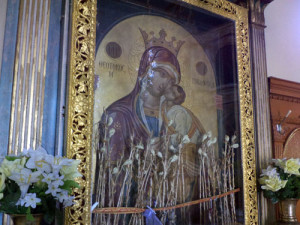Lilies of the Mother of God is a blessing to the foremost part of the village preserved from the island of Kefalonia, Greece. In the village church, every year, the same miracle happens: lilies placed on the icon of Virgin Mary, although completely dry, bloom for the second time, marvelously, so on August 15, when Christians celebrate the Dormition of the Mother of God, they are fully in bloom, undried and fragrant.
The lily has been associated since antiquity, by Christian tradition, the Annunciation, when the Angel Gabriel brought the Virgin Mary the good news of salvation. As we see, in some icons of the Annunciation, the Archangel is holding a lily flower as a symbol of purity and beauty. Lily flowers are royal flowers, fragrant particularly chosen and are often placed before imperial icons and holy shrines.
In the Greek island Kefalonia, between the towns Troghianata and Demutandata, a short distance from the island’s capital, Argostoli, is Langouvartha city, which hosts the annual miracle of flowering for the second time, lilies are brought to the faithful Virgin, during year. The Local church is called, in the flesh, “Church of Our Lady of Lilies” and white lilies in the church are known in the region as the “lilies of virgins”.
As soon as Christians celebrate Annunciation and lilies begin to bloom, especially in May, countless lilies are placed before the icon of the Virgin Mary church mentioned. Naturally, lilies, once picked, resist a few days, then permanently dry, unable to bloom again. This happens here, but after wilting and drying lilies, they are not taken away from the front of the icon of Our Lady, but are left in place until August 15.
Lilies placed before the icon of the Virgin of this church flourish for the second time, miraculously, every year, on August 15, when Christians celebrate the Assumption. Although blooming for the second time, with petals and flowers in full bloom, the bottom of them remains dry, as if to further strengthen the miracle.
 The small church in Pastra, located in the northern part of the island, is blessed with the same yearly miracle blossom. In the courtyard of the church, named “The Assumption”, countless white lilies are planted. In May, when the lilies start to blossom and flourish, village women collect them and bring them in church, before the icon of the Virgin. A few days after they’re picked, the lilies wither and dry. As in the other church, they are not discarded but left before the wonderful icon. During the Fast, between August 1 and 15, laws of nature are overcome, strengthening the Christian faith; dry lilies bloom once more before the eyes of all.
The small church in Pastra, located in the northern part of the island, is blessed with the same yearly miracle blossom. In the courtyard of the church, named “The Assumption”, countless white lilies are planted. In May, when the lilies start to blossom and flourish, village women collect them and bring them in church, before the icon of the Virgin. A few days after they’re picked, the lilies wither and dry. As in the other church, they are not discarded but left before the wonderful icon. During the Fast, between August 1 and 15, laws of nature are overcome, strengthening the Christian faith; dry lilies bloom once more before the eyes of all.
By the time the village was under the rule of Count Lianos sometime in early August, he sent messengers to field work. One of the workers, following the deal, found an icon of the Virgin in the grass. Beside it, was a white lily. Placing the icon in a haystack, the peasant went to announce his master, which did not have time to come see the icon. Finally, he told the peasant to bring the icon to the Church of St. Demetrius. That night, the ruler dreamed of the Mother of God and She told him not to take “Her home”. Terrified, he brought the icon to his house, where his daughter was sick at the time, but was cured miraculously. In gratitude, the man built a church on the site of the camp, where the icon was found.
In the town of Apikia , Cycladic island of Andros , Christian women grew ” lilies of the Virgin”, which bloom in May. These are again taken before the icon of the Virgin Mary, to receive blessings and to blossom again. Only the dry stem is left of these flowers, so on August 15, they become tender and full of wonderful fragrant flowers.
Local Christians have a story regarding these lilies: When the Dodecanese region was under Italian occupation in 1943, a Christian child took some white lilies and placed them before the icon of the Virgin. As expected, after a few days , the lilies have withered and dried. After several months through July, miraculously, the dried lilies came to life again, green and making buds. They bloomed on August 23 for the second time that year, releasing wonderful fragrance. Since 1943, when the first miracle of the blooming lilies took place, it was repeated annually, without exception.
Teodor Danalache

